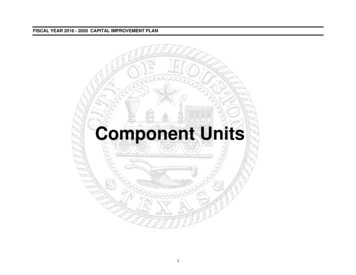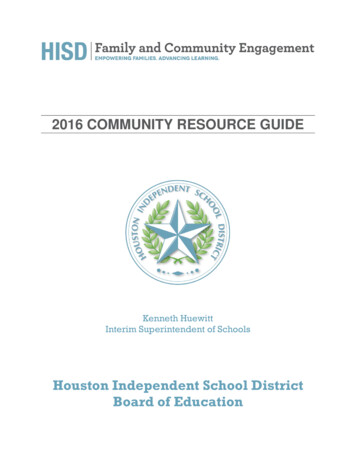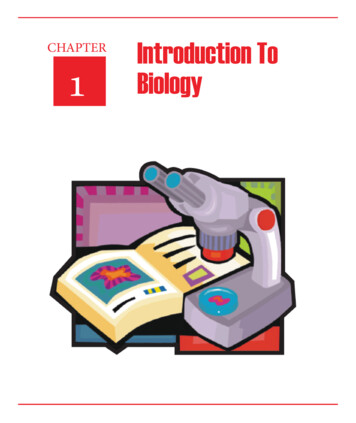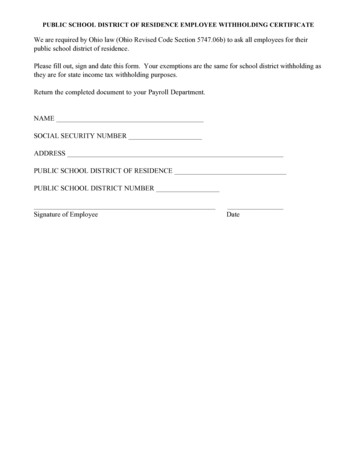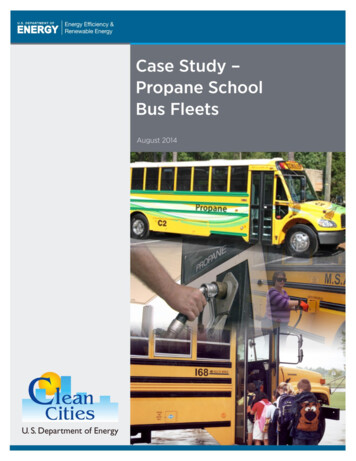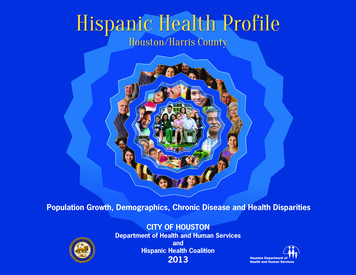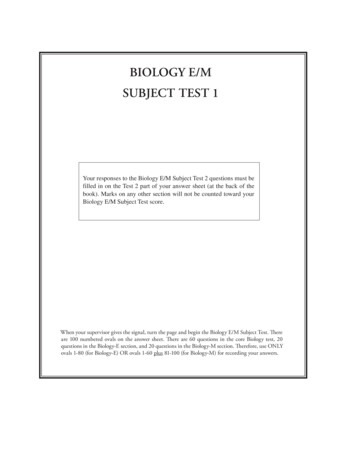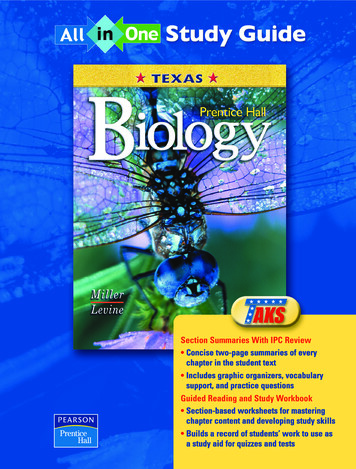
Transcription
Section Summaries With IPC Review Concise two-page summaries of everychapter in the student text Includes graphic organizers, vocabularysupport, and practice questionsGuided Reading and Study Workbook Section-based worksheets for masteringchapter content and developing study skills Builds a record of students’ work to use asa study aid for quizzes and tests
BiologyPrentice HallAll-in-One Study GuideUpper Saddle River, New JerseyBoston, Massachusetts
Copyright by Pearson Education, Inc., publishing as Pearson Prentice Hall, Boston, Massachusetts 02116. All rightsreserved. Printed in the United States of America. This publication is protected by copyright, and permission should beobtained from the publisher prior to any prohibited reproduction, storage in a retrieval system, or transmission in anyform or by any means, electronic, mechanical, photocopying, recording, or likewise. For information regarding permission(s),write to: Rights and Permissions Department, One Lake Street, Upper Saddle River, New Jersey 07458.Pearson Prentice Hall is a trademark of Pearson Education, Inc.Pearson is a registered trademark of Pearson plc.Prentice Hall is a registered trademark of Pearson Education, Inc.ISBN 0-13-115522-919 20 21 22 V001 13 12 11
How to Use the All-in-One Study GuideDid you know that learning to study more effectively can make a real difference inyour performance at school? Students who master study skills are more confidentand have more fun learning. This book, the All-in-One Study Guide for Prentice HallBiology, is designed to help you acquire the skills that will allow you to studybiology more effectively. Your active participation in class and use of this StudyGuide can go a long way toward helping you achieve success in biology.This Study Guide can be used to preview a chapter, learn key vocabulary terms, master difficult concepts, review for chapter and unit tests, and prepare for the Texas Assessment of Knowledgeand Skills (TAKS) in Science.Part 1 Section Summaries With IPC ReviewIPC Review The first part of this Study Guide will help you review the conceptsfrom Integrated Physics and Chemistry (IPC) that will be tested on the TAKS, ingrade 10 and grade 11. In addition, there are vocabulary terms from IPC and key formulas from IPC, with practice in usingeach of the formulas.Section Summaries A two-page summary for each chapter in Prentice Hall Biologyis also included in the first part of this Study Guide. The key concepts andvocabulary terms are summarized in an easy-to-read style. Use this portion of theStudy Guide to review what you have read in every section of the textbook and tocheck your understanding of the chapter content.The vocabulary reviews take a variety of formats including flowcharts, crosswordpuzzles, labeling, multiple-choice questions, and matching exercises. Pearson Education, Inc. All rights reserved.Part 2 Guided Reading and Study Workbook With IPC ReviewThe second part of this Study Guide provides a worksheet for every sectionwithin each chapter of your textbook and for the TAKS Handbook as well.Completing these worksheets will help you master the key concepts andvocabulary in each section.Each lesson in the Study Guide provides questions to help you understand thecontent found under each of the main headings in the textbook. Diagrams, charts,and word puzzles provide a variety of formats to help you master key terms.An activity that focuses on a particular reading strategy for each chapter is alsoprovided. These activities will help improve your reading skills. Strategies include outlining, sequencing information, identifying cause and effect, and identifying main ideas and supporting details.iii
Contents Pearson Education, Inc. All rights reserved.Section Summaries With IPC ReviewIntroduction.1Biology TEKS .2IPC Review .5Formula Chart.25IPC Vocabulary Review .26IPC Formula Review .28Chapter 1 The Science of Biology .33Chapter 2 The Chemistry of Life .36Chapter 3 The Biosphere .39Chapter 4 Ecosystems and Communities .42Chapter 5 Populations .45Chapter 6 Humans in the Biosphere .48Chapter 7 Cell Structure and Function .51Chapter 8 Photosynthesis.54Chapter 9 Cellular Respiration.57Chapter 10 Cell Growth and Division.60Chapter 11 Introduction to Genetics.63Chapter 12 DNA and RNA .66Chapter 13 Genetic Engineering .69Chapter 14 The Human Genome .72Chapter 15 Darwin’s Theory of Evolution .75Chapter 16 Evolution of Populations .78Chapter 17 The History of Life.81Chapter 18 Classification.84Chapter 19 Bacteria and Viruses .87Chapter 20 Protists .90Chapter 21 Fungi .93Chapter 22 Plant Diversity.96Chapter 23 Roots, Stems, and Leaves.99Chapter 24 Reproduction of Seed Plants .102Chapter 25 Plant Responses and Adaptations .105Chapter 26 Sponges and Cnidarians .108Chapter 27 Worms and Mollusks .111Chapter 28 Arthropods and Echinoderms.114Chapter 29 Comparing Invertebrates .117Chapter 30 Nonvertebrate Chordates, Fishes, and Amphibians .120Chapter 31 Reptiles and Birds .123Chapter 32 Mammals.126Chapter 33 Comparing Chordates .129Chapter 34 Animal Behavior .132Chapter 35 Nervous System .135Chapter 36 Skeletal, Muscular, and Integumentary Systems .138Chapter 37 Circulatory and Respiratory Systems .141Chapter 38 Digestive and Excretory Systems .144Chapter 39 Endocrine and Reproductive Systems.147Chapter 40 The Immune System and Disease .150Study Guide/Contentsv
Guided Reading and Study Workbook With IPC ReviewScience TAKS 4 Structures and Properties of MatterIPC TEKS 7 Matter and Its ComponentsIPC 7A Properties of Fluids .155IPC 7E Classifying Matter .156IPC 7D Chemical Behavior of Elements .156IPC TEKS 8 Changes in MatterIPC 8A Physical and Chemical Changes.159IPC 8C The Law of Conservation of Mass .161IPC TEKS 9 Chemistry of SolutionsIPC 9A The Structure and Function of Water .162IPC 9B Properties of Solutions .163IPC 9D Factors That Influence Solubility .164Science TAKS 5 Motion, Forces, and EnergyIPC TEKS 4 Force and MotionIPC 4A Motion, Work, and Power .165IPC 4B Newton’s Laws of Motion .166IPC 4D Efficiency of Machines .168IPC TEKS 5 WavesIPC 5A Wave Types and Characteristics .169IPC 5B Wave Interactions .171IPC TEKS 6 Energy TransformationsIPC 6A Energy.173IPC 6B Movement of Heat .174IPC 6F Series and Parallel Circuits .175IPC 6D Impact of Various Energy Sources .1771–1 What Is Science? .1791–2 How Scientists Work.1811–3 Studying Life.1841–4 Tools and Procedures .186Chapter 2 The Chemistry of Life2–1 The Nature of Matter .1892–2 Properties of Water.1912–3 Carbon Compounds.1942–4 Chemical Reactions and Enzymes .197Chapter 3 The Biosphere3–1 What Is Ecology? .2003–2 Energy Flow .2023–3 Cycles of Matter.205viStudy Guide/Contents Pearson Education, Inc. All rights reserved.Chapter 1 The Science of Biology
Chapter 4 Ecosystems and Communities4–1 The Role of Climate .2084–2 What Shapes an Ecosystem?.2104–3 Biomes .2124–4 Aquatic Ecosystems.216Chapter 5 Populations5–1 How Populations Grow.2205–2 Limits to Growth .2235–3 Human Population Growth .225Chapter 6 Humans in the Biosphere6–1 A Changing Landscape.2286–2 Renewable and Nonrenewable Resources.2306–3 Biodiversity .2336–4 Charting a Course for the Future.236Chapter 7 Cell Structure and Function7–1 Life Is Cellular.2387–2 Eukaryotic Cell Structure .2407–3 Cell Boundaries.2447–4 The Diversity of Cellular Life.247Chapter 8 Photosynthesis8–1 Energy and Life.2498–2 Photosynthesis: An Overview .2518–3 The Reactions of Photosynthesis.253Chapter 9 Cellular Respiration9–1 Chemical Pathways.2579–2 The Krebs Cycle and Electron Transport .260 Pearson Education, Inc. All rights reserved.Chapter 10 Cell Growth and Division10–1 Cell Growth .26510–2 Cell Division.26610–3 Regulating the Cell Cycle.269Chapter 11 Introduction to Genetics11–1 The Work of Gregor Mendel .27111–2 Probability and Punnett Squares.27311–3 Exploring Mendelian Genetics .27511–4 Meiosis.27811–5 Linkage and Gene Maps.280Chapter 12 DNA and RNA12–1 DNA .28212–2 DNA Chromosomes and Replication .28512–3 RNA and Protein Synthesis .28712–4 Mutations.29012–5 Gene Regulation .292Study Guide/Contentsvii
Chapter 13 Genetic Engineering13–1 Changing the Living World .29613–2 Manipulating DNA .29813–3 Cell Transformation .30113–4 Applications of Genetic Engineering.303Chapter 14 The Human Genome14–1 Human Heredity .30614–2 Human Chromosomes.30914–3 Human Molecular Genetics .312Chapter 15 Darwin’s Theory of Evolution15–1 The Puzzle of Life’s Diversity .31615–2 Ideas That Shaped Darwin’s Thinking .31915–3 Darwin Presents His Case.321Chapter 16 Evolution of Populations16–1 Genes and Variation.32516–2 Evolution as Genetic Change .32816–3 The Process of Speciation .330Chapter 17 The History of Life17–1 The Fossil Record .33317–2 Earth’s Early History .33617–3 Evolution of Multicellular Life.33917–4 Patterns of Evolution .342Chapter 18 Classification18–1 Finding Order in Diversity .34518–2 Modern Evolutionary Classification .34718–3 Kingdoms and Domains.349Chapter 19 Bacteria and VirusesChapter 20 Protists20–1 The Kingdom Protista.36120–2 Animallike Protists: Protozoans .36320–3 Plantlike Protists: Unicellular Algae.36620–4 Plantlike Protists: Red, Brown, and Green Algae.36920–5 Funguslike Protists.372Chapter 21 Fungi21–1 The Kingdom Fungi .37521–2 Classification of Fungi .37821–3 Ecology of Fungi.382viiiStudy Guide/Contents Pearson Education, Inc. All rights reserved.19–1 Bacteria.35319–2 Viruses.35719–3 Diseases Caused by Bacteria and Viruses.359
Chapter 22 Plant Diversity22–1 Introduction to Plants .38422–2 Bryophytes.38722–3 Seedless Vascular Plants.39022–4 Seed Plants.39322–5 Angiosperms—Flowering Plants .397Chapter 23 Roots, Stems, and Leaves23–1 Specialized Tissues in Plants .40023–2 Roots .40323–3 Stems .40523–4 Leaves.40823–5 Transport in Plants .410Chapter 24 Reproduction of Seed Plants24–1 Reproduction With Cones and Flowers.41324–2 Seed Development and Germination .41824–3 Plant Propagation and Agriculture.420Chapter 25 Plant Responses and Adaptations25–1 Hormones and Plant Growth .42325–2 Plant Responses .42625–3 Plant Adaptations.428Chapter 26 Sponges and Cnidarians26–1 Introduction to the Animal Kingdom .43126–2 Sponges .43526–3 Cnidarians .437Chapter 27 Worms and Mollusks Pearson Education, Inc. All rights reserved.27–1 Flatworms .44127–2 Roundworms.44427–3 Annelids .44627–4 Mollusks.449Chapter 28 Arthropods and Echinoderms28–1 Introduction to the Arthropods.45328–2 Groups of Arthropods .45628–3 Insects .45928–4 Echinoderms.462Chapter 29 Comparing Invertebrates29–1 Invertebrate Evolution.46529–2 Form and Function in Invertebrates.468Chapter 30 Nonvertebrate Chordates, Fishes, and Amphibians30–1 The Chordates .47230–2 Fishes .47430–3 Amphibians .478Study Guide/Contentsix
Chapter 31 Reptiles and Birds31–1 Reptiles.48231–2 Birds.485Chapter 32 Mammals32–1 Introduction to the Mammals.48932–2 Diversity of Mammals .49232–3 Primates and Human Origins .494Chapter 33 Comparing Chordates33–1 Chordate Evolution .49833–2 Controlling Body Temperature.50033–3 Form and Function in Chordates.502Chapter 34 Animal Behavior34–1 Elements of Behavior .50634–2 Patterns of Behavior .509Chapter 35 Nervous System35–1 Human Body Systems .51235–2 The Nervous System .51435–3 Divisions of the Nervous System .51635–4 The Senses.51835–5 Drugs and the Nervous System .521Chapter 36 Skeletal, Muscular, and Integumentary Systems36–1 The Skeletal System.52436–2 The Muscular System .52736–3 The Integumentary System.530Chapter 37 Circulatory and Respiratory Systems37–1 The Circulatory System .53337–2 Blood and the Lymphatic System .53637–3 The Respiratory System.53838–1 Food and Nutrition .54238–2 The Process of Digestion .54538–3 The Excretory System .548Chapter 39 Endocrine and Reproductive Systems39–1 The Endocrine System .55139–2 Human Endocrine Glands .55439–3 The Reproductive System .55739–4 Fertilization and Development .560Chapter 40 The Immune System and Disease40–1 Infectious Disease .56340–2 The Immune System .56540–3 Immune System Disorders.56840–4 The Environment and Your Health .570xStudy Guide/Contents Pearson Education, Inc. All rights reserved.Chapter 38 Digestive and Excretory Systems
BiologyPrentice HallSection SummariesWith IPC Review Concise two-page summaries of every chapterin the Student Edition Pearson Education, Inc. All rights reserved. One-page vocabulary review per chapter,including graphic organizers and practicequestions
INTRODUCTIONIn grades 10 and 11, you will take the test called the Texas Assessment ofKnowledge and Skills, or TAKS, in science. The TAKS objectives are based onthe learning requirements listed in the Texas Essential Knowledge and Skills, orTEKS. The chart below lists the science TAKS objectives that are tested in grades10 and 11; it also lists the number of questions that relate to each TAKS objective. Notice that both tests include questions related to objectives for integratedphysics and chemistry (IPC) as well as biology.You can take steps to improve your performance and increase your chancesof doing well on the test, and your biology textbook will help you take thesesteps. In each chapter, Prentice Hall Biology has many features that prepare youfor the TAKS. On the following pages, you will find an overview of the BiologyTEKS. Those TEKS that are tested in grades 10 and 11 are also noted in thisoverview.You may be concerned about the IPC questions, because right now youaren’t taking a course in integrated physics and chemistry. To address yourconcern about IPC TAKS questions, use the following summary to review theconcepts in physical science and chemistry on which the IPC TAKS questionswill be based. You can refresh your memory of these concepts by reading theseexplanations and completing the IPC TEKS vocabulary and formula reviewsthat follow.While no one enjoys taking any test, the science TAKS does not need to bea scary experience. If you use the TAKS-preparation features in Prentice HallBiology, you should be well prepared for the exam. Pearson Education, Inc. All rights reserved.Texas Assessment of Knowledge and Skills (TAKS)Number of QuestionsTAKS ObjectiveGrade 10Grade 111. The student will demonstrate an understanding of thenature of science.17172. The student will demonstrate an understanding of theorganization of living systems.1183. The student will demonstrate an understanding of theinterdependence of organisms and the environment.1184. The student will demonstrate an understanding of thestructures and properties of matter.8115. The student will demonstrate an understanding of motion,forces, and energy.8115555Total number of test itemsSection Summaries/TAKS Handbook1
Biology TEKSIntroductionStudents should understand a whole interms of its components and how thesecomponents relate to each other and tothe whole. All systems have basic properties that can be described in ter
Biology Prentice Hall All-in-One Study Guide Upper Saddle River, New Jersey Boston, Massachusetts. ISBN -13-115522-9 . This book, the All-in-One Study Guidefor Prentice Hall Biology, is designed to help you acquire the skills that will allow you to study biology more effectively. Your active participation in class and use of this Study
